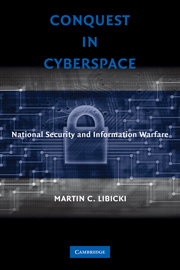Book contents
- Frontmatter
- Contents
- List of Figures
- Acknowledgments
- 1 Introduction
- 2 Hostile Conquest as Information Warfare
- 3 Information Warfare as Noise
- 4 Can Information Warfare Be Strategic?
- 5 Information Warfare Against Command and Control
- 6 Friendly Conquest in Cyberspace
- 7 Friendly Conquest Using Global Systems
- 8 Retail Conquest in Cyberspace
- 9 From Intimacy, Vulnerability
- 10 Talking Conquest in Cyberspace
- 11 Managing Conquest in Cyberspace
- Appendix A Why Cyberspace Is Likely to Gain Consequence
- Index
2 - Hostile Conquest as Information Warfare
Published online by Cambridge University Press: 05 June 2012
- Frontmatter
- Contents
- List of Figures
- Acknowledgments
- 1 Introduction
- 2 Hostile Conquest as Information Warfare
- 3 Information Warfare as Noise
- 4 Can Information Warfare Be Strategic?
- 5 Information Warfare Against Command and Control
- 6 Friendly Conquest in Cyberspace
- 7 Friendly Conquest Using Global Systems
- 8 Retail Conquest in Cyberspace
- 9 From Intimacy, Vulnerability
- 10 Talking Conquest in Cyberspace
- 11 Managing Conquest in Cyberspace
- Appendix A Why Cyberspace Is Likely to Gain Consequence
- Index
Summary
Information systems, the basis of cyberspace, are powerful and hence valuable. But they are also complex and hence often incomprehensible. As tools they should be subject to our mastery. But do we really control them? Even our stand-alone systems may arrive corrupted or may become corrupted through something they ingest. Connect them to the world, whether by yesterday's floppy disks or today's networks, and our fears multiply – and not without justification. Will these systems be available to do our bidding when asked – or will they sicken with viruses or drown in spam? Will information we entrust to our systems stay put or follow some Pied Piper out of town? Can we even be sure that the information they present to us has not been tampered with?
This combination of growing dependence and ever-shaky confidence in our control over information systems has given rise, since the early 1990s, to a new type of threat, and conversely and consequently a new branch of the military art: information warfare. Information warfare is often epitomized by hostile operations in cyberspace although, as explained shortly, it can take place in other ways.
This, the first of four chapters on hostile operations in cyberspace, builds an archetype of information warfare and then works backward to its epitome – computer network attack. Embedding computer network attack within a broader context of information warfare provides a sense of where it stands within the whole military milieu.
- Type
- Chapter
- Information
- Conquest in CyberspaceNational Security and Information Warfare, pp. 15 - 49Publisher: Cambridge University PressPrint publication year: 2007



